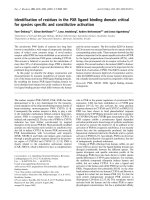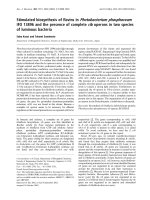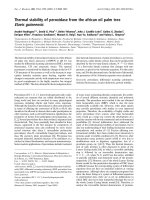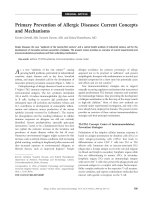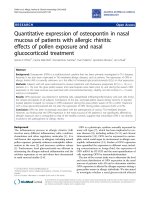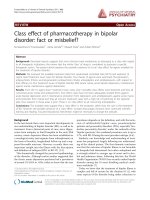Báo cáo y học: "Antiviral therapy of HCV in the cirrhotic and transplant candidate"
Bạn đang xem bản rút gọn của tài liệu. Xem và tải ngay bản đầy đủ của tài liệu tại đây (209.99 KB, 4 trang )
Int. J. Med. Sci. 2006, 3
75
International Journal of Medical Sciences
ISSN 1449-1907 www.medsci.org 2006 3(2):75-78
©2006 Ivyspring International Publisher. All rights reserved
Review
Antiviral therapy of HCV in the cirrhotic and transplant candidate
Steven K. Herrine, and Victor J. Navarro
Division of Gastroenterology and Hepatology, Thomas Jefferson University, 132 S. 10
th
Street, Suite 450, Philadelphia, PA 19107,
USA.
Corresponding address: Steven K. Herrine, MD, Division of Gastroenterology and Hepatology, Thomas Jefferson University, 132 S.
10
th
Street, Suite 450, Philadelphia, PA 19107, USA. Telephone: 215.955.5247 Fax: 215.503.2146 Email:
Received: 2005.12.30; Accepted: 2006.03.01; Published: 2006.04.01
Despite the improved efficacy of peginterferons, the rate of sustained virologic response is suboptimal in cirrhotic
patients, relative to non-cirrhotic patients. However, the treatment of patients with compensated cirrhosis has recently
been encouraged by expert panels. Interferon-based therapy may provide additional benefit by reducing the risk of
hepatocellular carcinoma in cirrhotic patients as suggested in preliminary studies. Results of two ongoing prospective
studies are awaited to answer the important question of the effectiveness of suppressive interferon therapy, even in the
absence of sustained virologic response. Given the importance of recurrent HCV following liver transplantation,
attention has been directed toward the antiviral treatment of patients with advanced liver disease. This approach needs
to be pursued with caution given the potential morbidity of the therapy. Recently, a low accelerating dosage regimen
has provided excellent results and is the subject of additional inquiry.
Key words: hepatitis C virus, cirrhosis, liver transplantation, antiviral therapy
1. Treatment in compensated cirrhosis
The response to interferon-based therapy for patients
with compensated cirrhosis due to hepatitis C has been
evaluated in several trials, both as the focus of prospective
study, as well as in subgroup (post hoc) analyses of large
registration trials. Despite the improved efficacy of
peginterferons, the sustained virological response (SVR)
rate is suboptimal in cirrhotic patients, relative to non-
cirrhotic patients. However, the treatment of patients
with compensated cirrhosis has recently been encouraged
by the International Liver Transplant Society Expert Panel
in 2003 which concluded that patients with relatively
compensated cirrhosis, defined by a MELD score of 18 or
less, are acceptable treatment candidates. [1]
The likelihood of achieving an SVR with interferon-
based therapy in cirrhotic patients can be deduced from
prior studies which focused upon, or incorporated
patients with, advanced fibrosis. Arguably, the most
important trial on this issue was conducted by Heathcote
and colleagues in patients with advanced stage fibrosis or
cirrhosis. [2] Patients were randomized to peginterferon
α-2a, at one of two doses (90 mcg or 180 mcg weekly), or
standard interferon. Two thirds of those entered had
cirrhosis. The SVR rate was greatest for those treated with
peginterferon alpha-2a 180 mcg weekly for 48 weeks
(30%); this is in comparison to a SVR rate of only 8% in
those treated with standard, thrice weekly, interferon. In
subgroup analysis comparing those with bridging fibrosis
to those with cirrhosis, there did not appear to be a
statistically significant difference between the groups in
terms of achieving an SVR. The patients infected with
genotype 1 who received the 180 mcg dose of pegylated
interferon had a 12% SVR rate, in comparison to 51% non-
type 1 genotypes treated with this dose.
Further analysis of data from the Heathcote trial
revealed that treatment was associated with histological
improvement, especially in the group that experienced an
SVR. Comparing the pegylated interferon group (180
mcg) group to standard interferon, histological
improvement occurred in 54% and 31% respectively.
Pertinent to the issue of histological effects of therapy,
Poynard pooled data retrospectively from 4 large
randomized controlled trials that included paired
biopsies. [3] This analysis included data on 3,010 patients
treated for either 24 or 48 weeks. Overall, improvement in
both the inflammatory grade and histologic stage of
disease were associated with therapy. Longer duration of
therapy strengthened this association. Of the 153 cirrhotic
patients with SVR included in this analysis, 75 (49%) had
significant improvement in fibrosis after treatment.
Interferon-based therapy may provide additional
benefit by reducing the risk of hepatocellular carcinoma in
cirrhotic patients as suggested in preliminary studies. In a
study among 103 patients with HCV-related cirrhosis,
those receiving interferon had a lower incidence of
hepatocellular carcinoma and improved survival after 4
years. [4] A reduction in the risk for hepatocellular
carcinoma in cirrhotic patients was also detected in a
Japanese trial of patients on interferon monotherapy for a
median of 3 years. [5] Therefore, in addition to
establishing a target for therapeutic efficacy in patients
with advanced fibrosis, early studies suggest potential
histological and survival benefits of interferon-based
treatment.
Insight into the efficacy of combination therapy with
pegylated interferon and ribavirin in cirrhotic patients can
be obtained from the large registration trials for pegylated
interferon. In the peginterferon alfa-2b registration trial,
the 6% of participants that had cirrhosis demonstrated a
lower SVR rate compared to those study subjects without
cirrhosis. [6] Cirrhotic patients treated with pegylated
interferon alfa-2b, 1.5 mcg/kg weekly in plus ribavirin 800
mg a day for 48 weeks had a 44% SVR; in comparison,
patients treated with standard interferon alfa-2b, 3 million
Int. J. Med. Sci. 2006, 3
76
units three times a week plus ribavirin for 48 weeks had a
slightly lower response rate of 41%. In the second
published pivotal trial of combined therapy with
pegylated interferon and ribavirin, cirrhotic patients
treated with peginterferon alfa-2a plus ribavirin for 48
weeks had SVR rate of 43%, compared to 33% in patients
treated with standard interferon combined with ribavirin.
Non-cirrhotic patients enrolled into this study had SVR
rates of 58% and 46% respectively. [7]
Results of two ongoing prospective studies are
awaited to answer an important question that remains; is
there any benefit of prolonged treatment of patients with
advanced fibrosis or cirrhosis, even in the absence of SVR?
The National Institutes of Health sponsored HALT-C trial
(Hepatitis C Antiviral Long Term Treatment against
Cirrhosis), is a multicenter study of the potential benefit of
prolonged peginterferon therapy in mitigating the
progression of fibrotic liver disease. [8] In this study, 391
of the 1045 patients enrolled into the initial “lead-in”
phase had biopsy proven cirrhosis. Preliminary results
show that cirrhosis alone impaired response to therapy,
with lower SVR rates compared to non-cirrhotic patients.
[9] In the COPILOT study (Colchicine Versus PEG-Intron
Long Term), enrollees are predominantly cirrhotic
patients who failed prior treatment. [10] An interim
analysis suggested a benefit to pegylated interferon
therapy, over colchicine, in reducing complications
associated with cirrhosis. Long term outcome data from
this trial and other suppressive protocols will determine
the efficacy of such an approach. [11]
In summary, patients with advanced fibrosis or
cirrhosis have a lower SVR compared to non-cirrhotic
patients, even with the latest combination therapy.
However, existing data support therapy of the patient
with compensated cirrhosis. Cirrhotic patients may
tolerate therapy less well, given the propensity for
thrombocytopenia and leucopenia, as was seen in the
three large trials that included cirrhotic patients. [2, 4, 11]
In practice, growth factors are commonly used to counter
the treatment related cytopenias. The use of these agents
is costly and has not been studied rigorously in a
randomized controlled format to assess their value and
impact on efficacy of therapy although they are now
widely used in patients receiving interferon therapy.
2. Treatment of advanced liver disease
Chronic HCV infection is the leading indication for
liver transplantation (LT) in the United States and Europe.
Given the accelerated progression of HCV following LT,
the observation than higher pre-transplant viral load is
associated with poorer transplant outcome, and the
difficulties in treatment of the infection following LT [12],
it is reasonable to emphasize the importance of pre-
transplant treatment of HCV. The International Liver
Transplantation Society Expert Panel provided guidelines
when considering interferon-based treatment in patients
with HCV-cirrhosis. As seen in Table 1, this group advises
treatment even in some patients with advanced cirrhosis.
Table 1.
International Liver Transplantation Society Expert
Panel Consensus Conference proposed guidelines for interferon-
based treatment of patients with cirrhosis [1]
Consider Treatment CTP Score MELD Score
Strongly consider ≤7 ≤18
In select cases 8-11 18-25
Treatment not advised >11 >25
Clearly, there are major obstacles toward treatment
of this group of patients. Since the advent of MELD-based
allocation, with the associated lessened importance of
waiting time, those awaiting liver transplant are more ill.
The resulting poor synthetic function, presence of hepatic
encephalopathy and hypersplenism limit the candidacy of
patients for interferon-based therapies. Pre-transplant
HCV treatment enthusiasm has also been curbed by the
lower rates of sustained virologic response in those with
fibrotic disease compared to those with less severe
histology. Several advances in HCV therapy have allowed
incremental progress in overcoming these hurdles. As
described above, peginterferons have shown better
efficacy that unmodified interferons in the treatment of
cirrhotic stage HCV. [2] Additionally, the use of growth
factors, specifically G-CSF and erythropoietin, has
allowed more aggressive dosing of interferon and
ribavirin. [13, 14] Finally, growing experience with
antiviral therapy in this high-risk group has led to novel
approaches and increasing success. Table 2 provides
details on the published results of antiviral therapy in this
difficult-to-treat population.
Table 2.
Summary of results from interferon-based treatment
regimens in patients with advanced liver disease
ref year regimen N G1 CPT
B/C
CPT
mean
ETR SVR Dose reduction
VanThiel 13 1995 5MU/day 30 - - - 56% 46% -
Crippin 15 2002 various 15 85% - 11.9 33% - 0%
Thomas 16 2003 5MU/day 20 67% 80% 10 60% 20% 15%
Forns 17 2003 3MU/day
RBV 800
30 83% 50% - 30% 20% 63%
Everson 18 2005 LADR 124 70% 55% 7.4 46% 24% 22%
Early published results with interferon/ribavirin-
based regimens were unfavorable, leading to concern for
the safety of such an approach. Crippin and colleagues
randomized end-stage liver disease patients on the
transplant waiting list to three dose regimens: interferon
alfa-2b, 1 million units (MU) daily, interferon alfa-2b 3MU
t.i.w., and interferon alfa-2b 1MU daily with ribavirin 400
mg PO BID. [15] These very sick patients (CPT mean 11.9)
were subject to strict eligibility requirements: platelet
count > 45,000/mL, Hemoglobin > 11 g/dL, and absolute
neutrophil count (ANC)>1250/mL. Dose reductions or
study discontinuation were mandated for ANC < 750/mL
or platelets < 45,000/mL and ANC < 500/mL or platelets
< 20,000/mL, respectively. Ribavirin dose was decreased
for hemoglobin < 10 g/dL and discontinued for
hemoglobin < 8.0 g/dL. Of those patients screened, 47%
met entry criteria (most excluded for thrombocytopenia)
of whom 33% (5/15) cleared virus on treatment. Of two
patients that went to LT, one was a responder, but
relapsed. Of concern was the safety profile: 20 severe
adverse drug reactions were reported, including two
serious infections, one of which led to multi-organ system
Int. J. Med. Sci. 2006, 3
77
failure and death. Enrollment was discontinued well short
of intentions because of these complications.
Despite this setback, enthusiasm for pre-transplant
therapy was rekindled by additional studies. Thomas and
colleagues reported their experience with high-dose
unmodified interferon monotherapy in 2003. [16] This
report was similar to a similar protocol used in 1995 by
the same principal investigator. [13] Of the 20 patients
who were given interferon alfa-2b, 5MU/day
subcutaneously, 60% cleared virus on therapy and 20%
had SVR. Of those that cleared virus, 33% remained non-
viremic after liver transplantation. This regimen, which
employed G-CSF to maintain ANC > 1500 cells/mL was
well tolerated, with temporary dose discontinuation in
3/20 (15%).
Forns and colleagues used relatively high-dose
interferon/ribavirin therapy in their cohort of 30 patients
awaiting transplantation in Spain in an effort to reduce
viral load at the time of LT. [17] When the investigators
estimated 4 months remained until transplantation,
interferon alfa-2b 3MU/day and ribavirin 800 mg/day
were initiated, with a resulting mean treatment period of
12 weeks in 30 patients. The virologic response rate on
therapy was 30%, with two-thirds of responders
remaining non-viremic after LT. As in other such trials
many wait-listed patients did not meet eligibility
requirements (38%), and side effects were common.
Despite the use of G-CSF and erythropoietin, dose
reduction of interferon was required in 60%, while
ribavirin dose was decreased in 23% of study patients.
Everson and colleagues offer the largest series to date
with a unique low accelerating dosage regimen (LADR).
[18] One hundred twenty four patients were treated with
unmodified interferon or peginterferon at low initial dose,
with increases every two weeks toward standard target
doses. Duration of therapy was intended to be 24 weeks in
genotypes 2 and 3 and 48 weeks in genotype 1 infection.
Hematologic inclusion criteria included ANC > 800
cells/mL, hemoglobin > 10 g/dL and platelets >
35,000/mL. Growth factors were allowed in the
management of therapy-induced cytopenias. The
investigators estimated that “one fourth to one sixth of the
patients referred to our clinic with advanced liver disease
were treated with LAD during his period.” End of
treatment response was seen in 46% while the SVR rate
was 22%. SVR was associated with non-1 genotype, CPT
class A, and a complete course of therapy. As expected in
this very ill set of patients, adverse drug reaction rates
were relatively common, with two such events potentially
contributing to patient mortality. Of the 15 patients that
were virologically negative at the time of transplantation,
12 remained HCV(-) for at least six months following LT.
Although the data are mixed on the effectiveness and
safety of interferon-based therapies in patients with
decompensated cirrhosis, the demonstrated possibility of
viral eradication in this group with possible improvement
in hepatic synthetic function and improved post-
transplant outcome provide an important rationale for
further studies in this area. Future work will focus on
pegylated accelerating dose regimens, the increased use of
growth factors and non-interferon based antiviral
therapies. Currently, it is advisable to treat such patients
only in experienced centers with close monitoring for
adverse events. [1, 19]
3. Research Direction
The morbidity of recurrent HCV following liver
transplantation has made pre-transplant antiviral therapy
a high priority for research. The low accelerating dosage
regimen of Everson and colleagues has demonstrated
good efficacy but must be replicated in other cohorts and
centers. The development of new, non-
immunomodulatory antiviral agents promises to be a
significant advance in the treatment of this population.
Ultimately, individualization of the anti-viral regimen
chosen in each case may lead to better efficacy rates with
less adverse drug reactions and side-effects.
Acknowledgements
The authors acknowledge Paul Martin, MD for his
reading of and comments on the manuscript.
Conflict of Interest
The authors have declared that no conflict of interest
exists.
References
1. Wiesner RH, Sorrell M, Villamil F. International Liver
Transplantation Society Expert Panel. Report of the first
International Liver Transplantation Society expert panel consensus
conference on liver transplantation and hepatitis C. Liver Transpl
2003;9:S1-9.
2. Heathcote EJ, Shiffman ML, Cooksley WG, Dusheiko GM, Lee SS,
Balart L, Reindollar R, Reddy RK, Wright TL, Lin A, Hoffman J, De
Pamphilis J. Peginterferon alfa-2a in patients with chronic hepatitis c
and cirrhosis. N Engl J Med 2000;343:1673-80.
3. Poynard T, McHutchison J, Manns M, Trepo C, Lindsay K, Goodman
Z, Ling MH, Albrecht J. Impact of pegylated interferon alfa-2b and
ribavirin on liver fibrosis in patients with chronic hepatitis C.
Gastroenterology 2002;122:1303-13.
4. Serfaty L, Aumaitre H, Chazouilleres O, Bonnand AM, Rosmorduc
O, Poupon RE, et al. Determinants of outcome of compensated
hepatitis C virus-related cirrhosis. Hepatology 1998;27:1435-1440.
5. Kasahara A, Hayashi N, Mochizuki K, Takayanagi M, Yoshioka K,
Kakumu S, Iijima A, Urushihara A, Kiyosawa K, Okuda M, Hino K,
Okita K. Risk factors for hepatocellular carcinoma and its incidence
after interferon treatment in patients with chronic hepatitis C.
Hepatology 1998;27:1394-1402.
6. Manns MP, McHutchison JG, Gordon SC, Rustgi VK, Shiffman M,
Reindollar R, Goodman ZD, Koury K, Ling M, Albrecht JK.
Peginterferon alfa-2b plus ribavirin for initial treatment of chronic
hepatitis C: a randomised trial. Lancet 2001;358:958-965.
7. Fried MW, Shiffman ML, Reddy KR, Smith C, Marinos G, Goncales
FL Jr, Haussinger D, Diago M, Carosi G, Dhumeaux D, Craxi A, Lin
A, Hoffman J, Yu J. Peginterferon alfa-2a plus ribavirin for chronic
hepatitis C virus infection. N Engl J Med 2002;347:975-82.
8. Lee WM, Dienstag JL, Lindsay KL, Lok AS, et al. Evolution of the
HALT C Trial: pegylated interferon as maintenance therapy for
chronic hepatitis C in previous interferon nonresponders. Control
Clin Trials 2004;25:472-92.
9. Everson GT, Hoefs JC, Malet P, et al. Impaired virologic response in
patients with advanced liver disease due to chronic hepatitis C is
independently linked to severity of disease; results from the HALT-C
trial. Hepatology 2004;40:180A.
10. Afdhal N., Freilich B., Levine R., Black M., et al. Colchicine versus
Peg-Intron Long Term (COPILOT) trial: Interim analysis of clinical
outcomes at year 2. Hepatology 2004;40:238A.
11. Poynard T, et al. Sustained virologic response (SVR) in the EPIC3
trial: week twelve virology predicts SVR in previous
interferon/ribavirin treatment failures receiving peg-intron/rebetol
(PR) weight based dosing (WBD). In: 40th Annual meeting of the
European Association for the Study of Liver Disease; April 13-17,
2005; Paris, France.
Int. J. Med. Sci. 2006, 3
78
12. Charlton M, Seaberg E, Wiesner R, Everhart J, Zetterman R, Lake J,
Detre K, Hoofnagle J. Predictors of patient and graft survival
following liver transplantation for hepatitis C. Hepatology
1998;28:823-30.
13. Van Thiel DH, Faruki H, Friedlander L, Fagiuoli S, Caraceni P,
Molloy PJ, Kania RJ, Wright HI. Combination treatment of advanced
HCV associated liver disease with interferon and G-CSF.
Hepatogastroenterology 1995;42:907-12.
14. Pockros PJ, Shiffman ML, Schiff ER, Sulkowski MS, Younossi Z,
Dieterich DT, Wright TL, Mody SH, Tang KL, Goon BL, Bowers PJ,
Leitz G, Afdhal NH; PROACTIVE Study Group.. Epoetin alfa
improves quality of life in anemic HCV-infected patients receiving
combination therapy. Hepatology 2004;40:1450-8.
15. Crippin JS, McCashland T, Terrault N, Sheiner P, Charlton MR. A
pilot study of the tolerability and efficacy of antiviral therapy in
hepatitis C virus-infected patients awaiting liver transplantation.
Liver Transpl 2002;8:350-5.
16. Thomas RM, Brems JJ, Guzman-Hartman G, Yong S, Cavaliere P, Van
Thiel DH. Infection with chronic hepatitis C virus and liver
transplantation: a role for interferon therapy before transplantation.
Liver Transpl 2003;9:905-15.
17. Forns X, Garcia-Retortillo M, Serrano T, Feliu A, Suarez F, de la Mata
M, Garcia-Valdecasas JC, Navasa M, Rimola A, Rodes J. Antiviral
therapy of patients with decompensated cirrhosis to prevent
recurrence of hepatitis C after liver transplantation. J Hepatol
2003;39:389-96.
18. Everson GT, Trotter J, Forman L, Kugelmas M, Halprin A, Fey B, Ray
C. Treatment of advanced hepatitis C with a low accelerating dosage
regimen of antiviral therapy. Hepatology 2005;42:255-62.
19. Strader DB, Wright T, Thomas DL, Seeff LB. AASLD practice
guideline: diagnosis, management, and treatment of hepatitis C.
Hepatology 2004;39:1147-1171.


